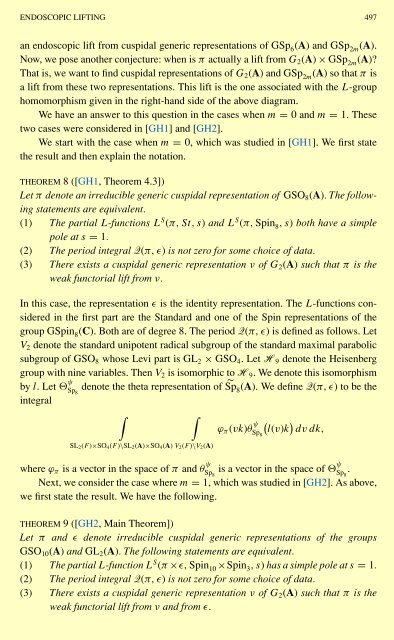A NULLSTELLENSATZ FOR AMOEBAS
A NULLSTELLENSATZ FOR AMOEBAS
A NULLSTELLENSATZ FOR AMOEBAS
Create successful ePaper yourself
Turn your PDF publications into a flip-book with our unique Google optimized e-Paper software.
ENDOSCOPIC LIFTING 497<br />
an endoscopic lift from cuspidal generic representations of GSp 6 (A) and GSp 2m (A).<br />
Now, we pose another conjecture: when is π actually a lift from G 2 (A) × GSp 2m (A)?<br />
That is, we want to find cuspidal representations of G 2 (A) and GSp 2m (A) so that π is<br />
a lift from these two representations. This lift is the one associated with the L-group<br />
homomorphism given in the right-hand side of the above diagram.<br />
We have an answer to this question in the cases when m = 0 and m = 1. These<br />
two cases were considered in [GH1] and[GH2].<br />
We start with the case when m = 0, which was studied in [GH1]. We first state<br />
the result and then explain the notation.<br />
THEOREM 8([GH1, Theorem 4.3])<br />
Let π denote an irreducible generic cuspidal representation of GSO 8 (A). The following<br />
statements are equivalent.<br />
(1) The partial L-functions L S (π, St, s) and L S (π, Spin 8 ,s) both have a simple<br />
pole at s = 1.<br />
(2) The period integral Q(π, ɛ) is not zero for some choice of data.<br />
(3) There exists a cuspidal generic representation ν of G 2 (A) such that π is the<br />
weak functorial lift from ν.<br />
In this case, the representation ɛ is the identity representation. The L-functions considered<br />
in the first part are the Standard and one of the Spin representations of the<br />
group GSpin 8 (C). Both are of degree 8. The period Q(π, ɛ) is defined as follows. Let<br />
V 2 denote the standard unipotent radical subgroup of the standard maximal parabolic<br />
subgroup of GSO 8 whose Levi part is GL 2 × GSO 4 .LetH 9 denote the Heisenberg<br />
group with nine variables. Then V 2 is isomorphic to H 9 . We denote this isomorphism<br />
by l. Let ψ Sp 8<br />
denote the theta representation of ˜Sp 8 (A). WedefineQ(π, ɛ) to be the<br />
integral<br />
∫<br />
∫<br />
ϕ π (vk)θ ψ ( )<br />
Sp 8<br />
l(v)k dv dk,<br />
SL 2 (F )×SO 4 (F )\SL 2 (A)×SO 4 (A) V 2 (F )\V 2 (A)<br />
where ϕ π is a vector in the space of π and θ ψ Sp 8<br />
is a vector in the space of ψ Sp 8<br />
.<br />
Next, we consider the case where m = 1, which was studied in [GH2]. As above,<br />
we first state the result. We have the following.<br />
THEOREM 9([GH2, Main Theorem])<br />
Let π and ɛ denote irreducible cuspidal generic representations of the groups<br />
GSO 10 (A) and GL 2 (A). The following statements are equivalent.<br />
(1) The partial L-function L S (π ×ɛ, Spin 10 ×Spin 3 ,s) has a simple pole at s = 1.<br />
(2) The period integral Q(π, ɛ) is not zero for some choice of data.<br />
(3) There exists a cuspidal generic representation ν of G 2 (A) such that π is the<br />
weak functorial lift from ν and from ɛ.
















